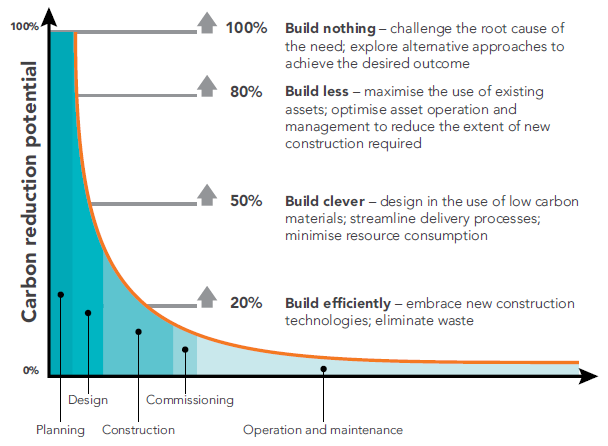3. Sustainable Construction
- There is significant energy consumption from building materials as a proportion of total UK industry energy consumption
- Poor health and safety within the construction industry
- Ageing workforce - older construction workers will struggle more with health and safety issues
Targets:
- Zero-carbon homes and buildings
- Incentives for insulation (operational sustainability)
- Reduce emissions from construction processes
Infrastructure Carbon Review 2013
Infrastructure takes a life cycle approach to reduce emissions, rather than a systems approach, which looks at the bigger issue, and could be responsible for unintended consequences.
Infrastructure has control over almost a sixth of total emissions and can have a significant contribution to national reduction.
Carbon - shorthand for carbon dioxide equivalent of all greenhouse gases, measured in tonnes of carbon dioxide equivalent.
Capital Carbon - emissions associated with the creation of an asset.
Embodied Carbon - emissions associated at the product level.
Operational Carbon - emissions associated with the operation and maintenance of an asset, quantified in tCO2e/year.
Whole life carbon - both capital and operational carbon.
It is predicted that whole-life carbon will reduce, but there will be an increasing significance of capital carbon, as the significance of operational carbon reduces.
Carbon reduction curve - shows that the potential to reduce carbon is highest at the start of a project, then decreases exponentially as the project progresses: 
Another example: Willmott Dixon 2030 Sustainable Development Strategy
Three themes supporting the UN sustainable development goals:
- Brilliant Buildings - 7, 9, 11, 13
- Building Lives - 4, 8, 10
- Better Planet - 9, 12, 13, 15
Approach to delivering net zero operational carbon:
- Reduce energy use
- Reduce embodied carbon
- Maximise renewable energy
- Measure and verify
Climate Change Adaptation
Buildings and infrastructure must now be designed to withstand the changes that result from climate change and global warming, e.g. warmer, drier summers; warmer, wetter winters; increase in extreme weather events, etc.
Changes must be made for infrastructure to survive in new conditions, e.g. designing foundations for the change in groundwater level and soil moisture that results from an increase in winter precipitation and a decrease in summer precipitation.
Other Goals and Strategies
Water: code for sustainable homes standards by 2010, reductions for government office buildings, water use in construction reduced by 20% from 2008 to 2012 (water footprint standards, company efforts and award schemes)
Biodiversity: biodiversity surveys for larger projects (achieved on a voluntary basis and as part of award schemes)
Materials: full product life-cycle studies to identify problems (not achieved), life-cycle information for designers, responsible sourcing
Waste: significant reduction between 2008 and 2012 through SWMPs which are no longer required, and reduction in packaging waste